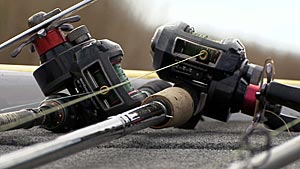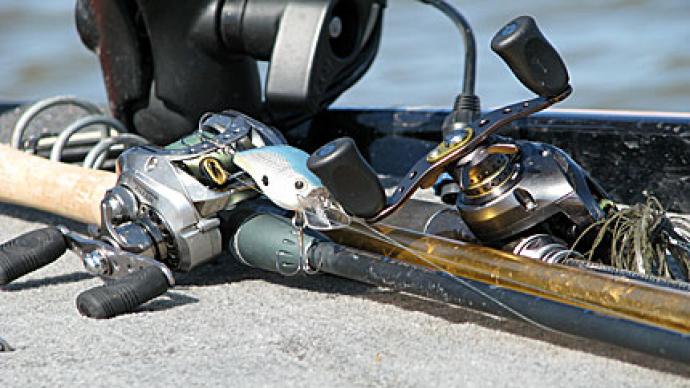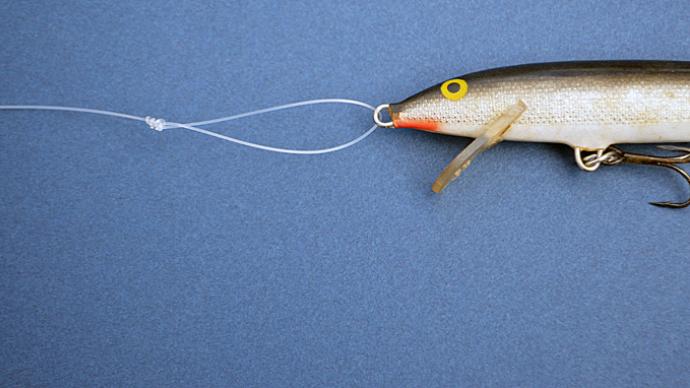
We anglers often talk about “confidence lures,” the lures we trust to catch fish. Equally important are “confidence lines” and “confidence knots” because the last thing most of us want to worry about while fishing is a bass breaking off due to inferior line or knot strength. And let’s face it. From time to time, we’ve all had doubts about the reliability of our lines and knots.
We’ve all wondered what knot works best with the line we’re using rather than the line used by some tester writing for a fishing magazine. Is it the revered Palomar knot or the more recently celebrated Uni-knot? Is it a knot treated with superglue or the same type without superglue treatment? Is it a knot of our invention?
Likewise, we’ve all wondered which line is stronger, irrespective of manufacturers’ claims, especially since there are no industry standards for pound-test ratings. For example, is it twelve-pound test for Stren Original, the same manufacturer’s test-rated Stren Super Knot, or maybe twelve-pound test for Sunline Super Natural? And are we trading off strength to go with the same pound test line with a smaller line diameter per manufacturers’ specifications?
Perhaps it’s time we all started doing our line and knot testing. But for those who don’t have the fancy equipment the industry testers use, not to worry! This article describes three inexpensive, simple, easy, and fun ways to test the relative strength of different lines or different knots by pitting line against line or knot against knot to determine which breaks first under a load.
Note: I have limited my use of this method to a maximum of twenty-pound test-rated lines. I don’t worry about marginal differences in relative line or knot strength when using heavier lines because it is with lighter lines that potentially small advantages in strength become critical for bass fishing. E.g., if one knot or line is ten-percent stronger than another, the difference between ten and eleven pounds of strength can be significant in avoiding a break-off. In contrast, a difference between thirty and thirty-three pounds of strength likely is not.
Tools And Materials
- Two heavy gauge hooks, 5/0 or larger (to exert a more direct pull, do not use offset style hooks)
- One heavy-duty, size five or larger, two-way barrel swivel (if pound test rated, be sure it exceeds the manufacturers’ pound test ratings of lines being used in the tests)
- Lines to be used in the tests
- One box-end wrench, large enough to get a good grip on the handle
- Eye protection and gloves for safety
- Different color marker pens to code items being tested to avoid confusion in recording results
- A log book to record the types of knots, as well as brands and specifications of lines being tested
Test 1: Line Against Line
This test reveals which of the two different lines has greater strength. They can be lines of different brands (e.g., Seaguar vs. Sufix or Spider Wire vs. Power Pro), different lines of the same brand (e.g., Berkley Trilene XL vs. Trilene XT), and even altogether different types of lines (nylon mono vs. fluorocarbon or pure fluorocarbon vs. a fluorocarbon hybrid line). Also, since nylon monofilament lines lose strength when wet, you can determine which retains the greatest strength. Just soak sections of different lines in the water for thirty minutes, and then run the Line-Against-Line test to determine the stronger-when-wet line. Note: To increase the variety of lines you test without breaking into your piggy bank, purchase a few yards each of different lines at a local tackle shop that fills fishing reels from bulk spools, or ask your fishing buddies for a couple of yards of the lines they use, and only purchase spools of the lines that successfully test out for your requirements.
Method
- Cut off a twelve-inch length of each of two different lines to be tested against one another.
- Use the same knot throughout the test, so only the relative strength of the two lines is at issue.
- Tie one end of each line to a different hook.
- Tie the other end of each line to a different end of the box swivel.
- Color code each line with a different marker pen for easy identification after breakage.
- Wear safety glasses and gloves for protection.
- Place one hook around a stationary, rigid object, such as a bar on a wrought iron fence, and place the other hook through the enclosed opening of the box-end wrench.
- Pull gently on the handle of the box-end wrench, slowly increasing pressure on the lines until one line breaks, thereby revealing the weaker line.
- Make sure that the same result is repeated three times to ensure any difference is not due to a poorly tied knot. Note: If neither line is consistently superior, then, for practical purposes, the lines are equivalently strong.
- Record results for future reference.
Test 2: Terminal Tackle Knot Against Terminal Tackle Knot
This test reveals which of two terminal tackle knots has greater strength when tied using the same line. These can be regular knots (e.g., Improved Clinch vs. the Orvis knot), loop knots (e.g., Rapala Knot vs. the Perfection Loop), or Snell knots (e.g., Basic Snell vs. the Power Snell)
Method
- Cut off an eighteen-inch length line you plan to use when fishing.
- Tie the hooks to opposite ends of the line using different terminal tackle knots.
- Color code each knot with a different marker pen for easy identification after breakage.
- Wear safety glasses and gloves for protection.
- Place one hook around a stationary, rigid object, such as a bar on a wrought iron fence, and place the other hook through the enclosed opening of the box-end wrench.
- Pull gently on the handle of the box-end wrench, slowly increasing pressure on the lines until one knot breaks, thereby revealing the weaker knot.
- Make sure that the same result is repeated three times with the same type of line to ensure any difference is not due to a poorly tied knot. Note: If neither knot is consistently superior with one type of line, then, for practical purposes, the knots are equivalently strong for that type of line.
- Also, repeat the test for each type of line you plan to use since specific knots work better with some lines than others (e.g., the better knot for nylon monofilament line might not be the better knot with a fluorocarbon line). Certain knots will just slip out with certain lines (e.g., the clinch knot will not hold the hook fast with braid line).
- Record results for future reference.
Test 3: Line-To-Line Knot Against Line-To-Line knot.
This test reveals which of two different line-to-line knots has greater strength when tied using the same lines. This typically applies to knots that attach leaders to the main line (e.g., Double Uni vs. the Surgeon’s).
Method
- Cut off two twelve-inch lengths of your favorite leader line and two twelve-inch lengths of your favorite main line.
- Using your favorite line to terminal tackle knot, tie a twelve-inch length of the leader line to one hook and a twelve-inch length of the main line to one end of the swivel.
- Using the same terminal tackle knot, tie the other twelve-inch length of the leader line to the other hook and the other twelve-inch length of the main line to the other end of the swivel.
- Tie the free end of one section of the main line to the free end of one section of the leader line using a line-to-line knot you wish to test, and then tie the free end of the other section of the main line to the free end of the other section of leader line using a different line-to-line knot you wish to test.
- Color-code each line-to-line knot with a different marker pen for easy identification after breakage.
- Wear safety glasses and gloves for protection.
- Place one hook around a stationary, rigid object, such as a bar on a wrought iron fence, and place the other hook through the enclosed opening of the box-end wrench.
- Pull gently on the handle of the box-end wrench, slowly increasing pressure on the lines until one of the line-to-line knots breaks, thereby revealing the weaker knot. Note: If your line-to-hook knot or line-to-swivel knot breaks before either line-to-line knot, you will need to find a stronger line-to-terminal tackle knot to complete the test.
- Make sure that the same result is repeated three times to ensure any difference is not due to a poorly tied knot. Note: If neither line-to-line-knot is consistently superior in the tests, then, for practical purposes, the knots are equivalently strong with the lines used.
- Record results for future reference.
Miscellaneous Testing of Terminal Tackle
Choosing stronger hooks and swivels when finesse fishing can be critically crucial because lighter terminal tackle is much more likely to fail when bass fishing than standard-size hooks and swivels. By suitably varying the methods described above, you can test those terminal tackle items against one another for strength. E.g., to discover which of two brands of hooks of a specific size or style is more likely to bend under a load, use a variation of the terminal tackle knot against terminal tackle knot method where you tie two different hooks together using a very heavy line, like sixty-five-pound braid and pull until one of the two hooks bends out. E.g., to determine which of two brands or styles of two-way swivels is stronger, use a variation of the line-against-line method where you tie each swivel to a different, very strong hook, like 8/0 size, with a very heavy line, like a sixty-five-pound braid, tie the swivels together using the same line, and pull until one of the swivels fails.
Outcomes
Some of the most beneficial results I have obtained with the various tests include the following:
- I found one manufacturer’s nylon monofilament line rated eight-pound test to be stronger than another manufacturer’s nylon monofilament line rated twelve-pound test, even though the eight-pound test line has a significantly smaller diameter per the manufacturer’s specifications.
- My favorite twenty-pound test nylon monofilament line proved stronger than my favorite twenty-pound fluorocarbon line, though both have the same line diameter per the manufacturer’s specifications.
- I determined that the knots I used for attaching terminal tackle and connecting lines to leaders were not as strong as others I checked out and now use instead.
Note: I do not include brand-specific results of my tests but leave it to other anglers to perform their tests and determine what lines and knots best meet their needs.
About the Author

Vince LaZara is a retired college professor who regularly angles avidly for largemouth bass in various southeastern Arizona lakes.




